Simple op-amp
PARTS AND MATERIALS
-
Two 6-volt batteries
-
Four NPN transistors -- models 2N2222 or
2N3403 recommended (Radio Shack catalog # 276-1617 is a
package of fifteen NPN transistors ideal for this and
other experiments)
-
Two PNP transistors -- models 2N2907 or
2N3906 recommended (Radio Shack catalog # 276-1604 is a
package of fifteen PNP transistors ideal for this and
other experiments)
-
Two 10 kΩ potentiometers, single-turn,
linear taper (Radio Shack catalog # 271-1715)
-
One 270 kΩ resistor
-
Three 100 kΩ resistors
-
One 10 kΩ resistor
CROSS-REFERENCES
Lessons In Electric Circuits, Volume
3, chapter 4: "Bipolar Junction Transistors"
Lessons In Electric Circuits, Volume
3, chapter 8: "Operational Amplifiers"
LEARNING OBJECTIVES
SCHEMATIC DIAGRAM
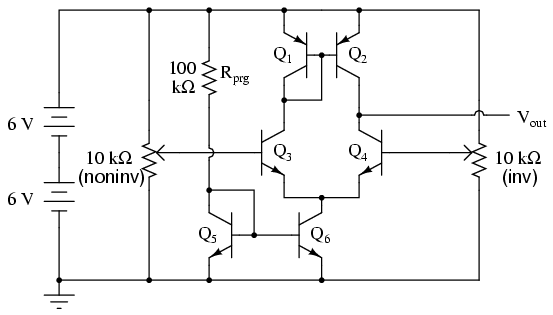
ILLUSTRATION
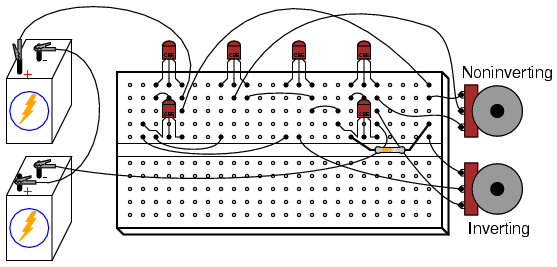
INSTRUCTIONS
This circuit design improves on the
differential amplifier shown previously. Rather than use
resistors to drop voltage in the differential pair circuit,
a set of current mirrors is used instead, the result being
higher voltage gain and more predictable performance. With a
higher voltage gain, this circuit is able to function as a
working operational amplifier, or op-amp. Op-amps
form the basis of a great many modern analog semiconductor
circuits, so understanding the internal workings of an
operational amplifier is important.
PNP transistors Q1 and Q2
form a current mirror which tries to keep current split
equally through the two differential pair transistors Q3
and Q4. NPN transistors Q5 and Q6
form another current mirror, setting the total
differential pair current at a level predetermined by
resistor Rprg.
Measure the output voltage (voltage at the
collector of Q4 with respect to ground) as the
input voltages are varied. Note how the two potentiometers
have different effects on the output voltage: one input
tends to drive the output voltage in the same direction (noninverting),
while the other tends to drive the output voltage in the
opposite direction (inverting). You will notice that the
output voltage is most responsive to changes in the input
when the two input signals are nearly equal to each other.
Once the circuit's differential response has
been proven (the output voltage sharply transitioning from
one extreme level to another when one input is adjusted
above and below the other input's voltage level), you are
ready to use this circuit as a real op-amp. A simple op-amp
circuit called a voltage follower is a good
configuration to try first. To make a voltage follower
circuit, directly connect the output of the amplifier to its
inverting input. This means connecting the collector and
base terminals of Q4 together, and discarding the
"inverting" potentiometer:
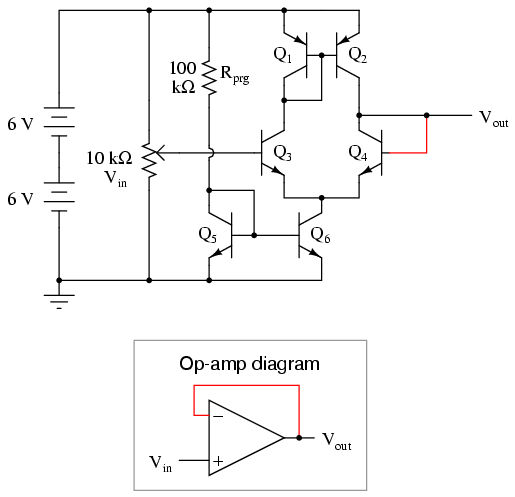
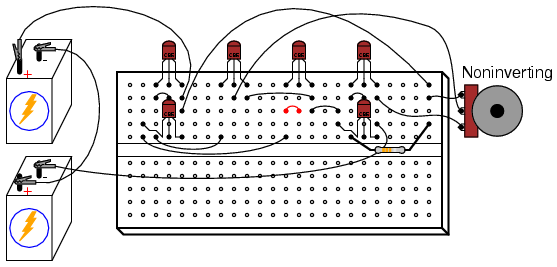
Note the triangular symbol of the op-amp
shown in the lower schematic diagram. The inverting and
noninverting inputs are designated with (-) and (+) symbols,
respectively, with the output terminal at the right apex.
The feedback wire connecting output to inverting input is
shown in red in the above diagrams.
As a voltage follower, the output voltage
should "follow" the input voltage very closely, deviating no
more than a few hundredths of a volt. This is a much more
precise follower circuit than that of a single
common-collector transistor, described in an earlier
experiment!
A more complex op-amp circuit is called the
noninverting amplifier, and it uses a pair of
resistors in the feedback loop to "feed back" a fraction of
the output voltage to the inverting input, causing the
amplifier to output a voltage equal to some multiple of the
voltage at the noninverting input. If we use two equal-value
resistors, the feedback voltage will be 1/2 the output
voltage, causing the output voltage to become twice the
voltage impressed at the noninverting input. Thus, we have a
voltage amplifier with a precise gain of 2:
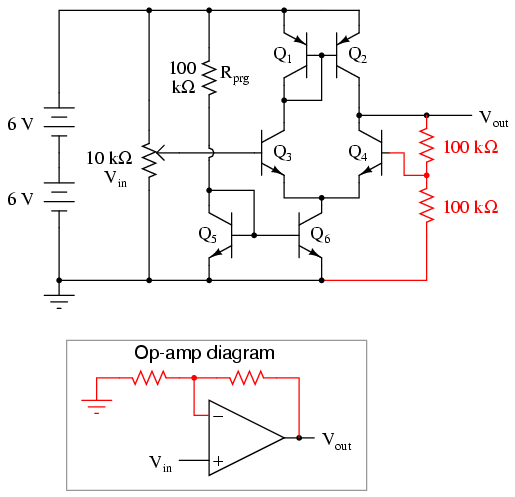
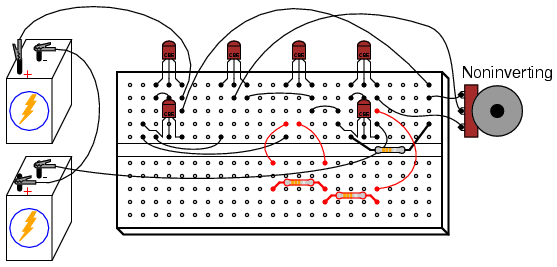
As you test this noninverting amplifier
circuit, you may notice slight discrepancies between the
output and input voltages. According to the feedback
resistor values, the voltage gain should be exactly 2.
However, you may notice deviations in the order of several
hundredths of a volt between what the output voltage is and
what it should be. These deviations are due to imperfections
of the differential amplifier circuit, and may be greatly
diminished if we add more amplification stages to increase
the differential voltage gain. However, one way we can
maximize the precision of the existing circuit is to change
the resistance of Rprg. This resistor sets the
lower current mirror's control point, and in so doing
influences many performance parameters of the op-amp. Try
substituting difference resistance values, ranging from 10
kΩ to 1 MΩ. Do not use a resistance less than 10 kΩ, or else
the current mirror transistors may begin to overheat and
thermally "run away."
Some operational amplifiers available in
prepackaged units provide a way for the user to similarly
"program" the differential pair's current mirror, and are
called programmable op-amps. Most op-amps are not
programmable, and have their internal current mirror control
points fixed by an internal resistance, trimmed to precise
value at the factory.
|